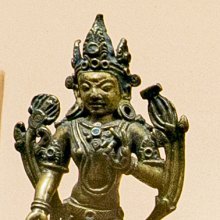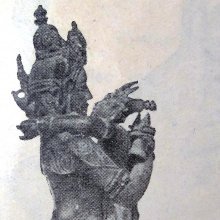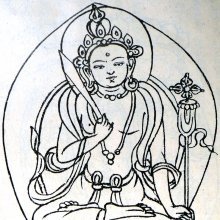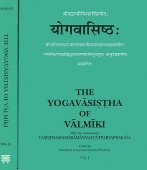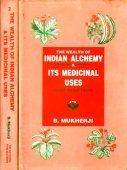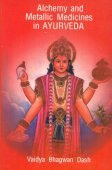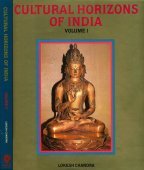Ignorance, Ignorant: 2 definitions
Introduction:
Ignorance means something in Hinduism, Sanskrit, Jainism, Prakrit. If you want to know the exact meaning, history, etymology or English translation of this term then check out the descriptions on this page. Add your comment or reference to a book if you want to contribute to this summary article.
Images (photo gallery)
In Hinduism
Yoga (school of philosophy)
Source: ORA: Amanaska (king of all yogas): A Critical Edition and Annotated Translation by Jason BirchIgnorant persons are denoted by the Sanskrit term Ajānat, according to the Haṭhapradīpikā of Svātmārāma: an influential 15th-century Sanskrit manual on Hatha-Yoga dealing with techniques to channel one’s vital energy.—Accordingly, “The compassionate Svātmārāma presents the Haṭhapradīpikā for those ignorant (ajānat) of Rājayoga because of their confusion in the darkness of many [conflicting] opinions”.

Yoga is originally considered a branch of Hindu philosophy (astika), but both ancient and modern Yoga combine the physical, mental and spiritual. Yoga teaches various physical techniques also known as āsanas (postures), used for various purposes (eg., meditation, contemplation, relaxation).
In Jainism
General definition (in Jainism)
Source: academia.edu: Tessitori Collection IIgnorance refers to one of the “thirteen difficulties”, according to the “Teraha kāṭhīyā-svādhyāya” by Jinaharṣa (dealing with the Ethics section of Jain Canonical literature), which is included in the collection of manuscripts at the ‘Vincenzo Joppi’ library, collected by Luigi Pio Tessitori during his visit to Rajasthan between 1914 and 1919.—The exposition of the ‘thirteen difficulties’ [e.g., ignorance (ajñāna)] against which one should fight as they are hindrances to proper religious practice is a widespread topic in Jain literature in Gujarati.

Jainism is an Indian religion of Dharma whose doctrine revolves around harmlessness (ahimsa) towards every living being. The two major branches (Digambara and Svetambara) of Jainism stimulate self-control (or, shramana, ‘self-reliance’) and spiritual development through a path of peace for the soul to progess to the ultimate goal.
See also (Relevant definitions)
Full-text (+1413): Ajnana, Avidya, Moha, Anabhijna, Abodha, Abuddhi, Ajnanin, Ajnata, Tamas, Ajna, Balisa, Maudhya, Tamoguna, Avicakshana, Jnananutpada, Apandita, Ajnanasiddha, Bhela, Ajnatva, Tama.
Relevant text
Search found 439 books and stories containing Ignorance, Ignorant; (plurals include: Ignorances, Ignorants). You can also click to the full overview containing English textual excerpts. Below are direct links for the most relevant articles:
Bhagavati-sutra (Viyaha-pannatti) (by K. C. Lalwani)
Part 10 - On the life of the celestial beings < [Chapter 5]
Part 2 - On the soul < [Chapter 10]
Part 4 - On tinge, outlook, etc., of infernals < [Chapter 5]
Maha Prajnaparamita Sastra (by Gelongma Karma Migme Chödrön)
I. Difference between omniscience and the knowledge of all the aspects < [VII. Winning omniscience and the knowledge of all the aspects]
The Śalyatvena-sūtra (Sallattena-sutta) < [Chapter XXXVII - The Ten Concepts]
Emptinesses 7-8: Emptiness of the conditioned unconditioned < [Chapter XLVIII - The Eighteen Emptinesses]
Mundaka Upanishad with Shankara’s Commentary (by S. Sitarama Sastri)
Verse 1.2.8 < [Mundaka I, Khanda II]
Verse 1.2.9 < [Mundaka I, Khanda II]
Verse 1.2.7 < [Mundaka I, Khanda II]
Taittiriya Upanishad Bhashya Vartika (by R. Balasubramanian)
Verse 2.541 < [Book 2 - Brahmavallī]
Verse 2.466 < [Book 2 - Brahmavallī]
Verse 2.459 < [Book 2 - Brahmavallī]
Brahma Sutras (Shankara Bhashya) (by Swami Vireshwarananda)
Chapter IV, Section II, Adhikarana IV < [Section II]
Chapter I, Section I, Adhikarana II < [Section I]
Yoga Vasistha [English], Volume 1-4 (by Vihari-Lala Mitra)
Chapter VI - The narration of delirium (moha) < [Book VI - Nirvana prakarana part 1 (nirvana prakarana)]
Chapter VIII - Allegory of the spreading arbour of ignorance < [Book VI - Nirvana prakarana part 1 (nirvana prakarana)]
Chapter CXIV - Description of error < [Book III - Utpatti khanda (utpatti khanda)]
Related products
